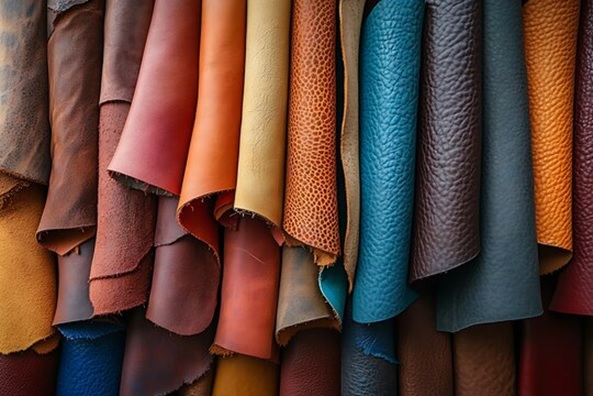
Ethiopia’s leather industry is a strategically important sector with significant potential for growth and export diversification. The country possesses abundant resources, including a large livestock population, and a trainable, competitively priced workforce. While the sector has faced challenges, including fluctuating exports and quality issues, new strategies and initiatives are being implemented to enhance its competitiveness and position Ethiopia as a leading leather producer.
One of the issues that Ethiopia is most concerned about in Africa is its livestock resources. Due to the abundance of livestock, it has the opportunity to be a leader in leather production. However, it is repeatedly criticized for not producing leather products that are competitive in the world market.
Supporting this idea, Industry Minister, Melaku Alebel said that it is appropriate to assess that the sector’s resources are not being utilized to the full extent of its potential. Customers’ needs in the sector are inconsistent; thus, products that are considered desirable quickly go out of fashion, and that the world is shifting from leather to synthetics; new needs and the requirements for penetrating the world market that are not compatible with the country’s producers have affected the sector.
In addition, COVID and security problems have had a significant impact on the sector; for this and other reasons, leather is still being thrown out. It requires a lot of work to bring about change in the sector; it is necessary to improve the strategy and identify industries that are better in the sector and can serve as models, he said.
He also mentioned that work is being done to solve the problems; in addition to individual support for industries in need; the Manufacturing Industry Council, which can provide joint support, is being established to give priority to the sector. Following this, industries that were closed are now being opened.
Zulfakir Abajobir, Director of the Leather Products Research Center, on his part said that since 2020, there has been a trend of decreasing leather exports. Study was conducted in 2023 to identify the situation where the sector has not progressed as required. The study identified that the country’s leather factories are scattered compared to the rest of the world.
He also said that there is a problem with the supply of inputs in the leather industry; limited use of technology and management in the sector; although there are international standards that leather factories must meet in terms of environmental and social issues, they were not met at the time of the study.
Mentioning that the sector has a gap in terms of financial provision, Zulfakir pointed out that there is a gap in terms of both the operating budget and foreign exchange. Although the foreign exchange shortage is being addressed through the macroeconomic reform implemented in the country, there is still a shortage of working capital. There is also limitation in terms of the promotion of leather products.
As to the Manager, in addition to supply problems of leather and hides in the sector, the quality of those provided is also a concern. Apart from the quality problem of the livestock, there are quality defects caused by humans after slaughtering the leather and hides until it reaches the factory.
Noting that more than 90% of slaughtering is done in private households, Zulfakir said that there is a problem with the collection of hides and skins of animals slaughtered in private households and their delivery to industries. For this, there are rules and regulations for the marketing system. However, he explained that there is an unresolved ownership issue.
He said that the Ministries of Agriculture, Trade and Regional Integration, and Industry, have discussed the problem in the marketing sector and are working to resolve the problem.
According to Zulfakir, there are 17 criteria that leather factories must meet in the production process, starting from environmental protection. When they meet these, they will receive a Leather Working Group (LWG) certificate. Two years ago, there was no factory in Ethiopia that met these criteria and had a certificate.
Obtaining the certificate is important to break into the global market. The process of obtaining this certificate should continue for other leather factories, Zulfakir said; currently, six factories have been able to obtain the certificate. Four of them are at the gold level; two of them are at the silver level.
When certified factories put their products on the market, global consumers will understand that the leather products they see on the shelf have been produced in a safe and environmentally friendly way from the beginning. This will have a great impact on the market, he said.
He recalled that the long chain of leather production from agricultural development to final production is another challenge for the sector; however, since the issue is related to animal resource development, the work done by the Ministry of Agriculture for animal meat and milk benefits the quality of leather and hide products. A situation has been created for this purpose to work together with the Ministry of Agriculture.
In order to overcome other problems, a review of the ten-year plan has been carried out. In this regard, the plan that will be implemented until 2033 has been discussed by leaders from top to district levels. The problems of the sector identified in the study and those set in the plan have begun to be implemented. Six leather factories that were closed have been reopened during the Ethiopia Tamirt (Made in Ethiopia) Movement, which is being carried out nationwide by the Ministry of Industry. Seven leather industries with 60 to 70% capacity in the leather sector are being identified and the problems they face in foreign trade are being solved, he said.
The Manager further stated that better production technology needs to be implemented; for this, he pointed out that efforts are being made to bring the technology they have implemented into the country by working with a leather research center in India, which has been in the sector for many years, and to create knowledge transfer in the country’s leather factories.
In order to convert leather waste into useful products, the sector has established relationships with the China Leather and Footwear Research Institute and the Central Leather Research Institute of India, and products that can be produced using waste products from the leather production process have been identified. The experiences gained from this process have started to be implemented in certain leather factories, he explained.
Since crocodile skin has a natural design on its own, it is in demand for bags and shoes, and its price is three to four times higher. Considering this, research was conducted; Crocodile skin was brought from Arba Minch and the leather was processed at the institute and delivered to leather factories. In this process, a factory called Carege Ethiopia has been supplying crocodile skin bags to the domestic and foreign markets and that it has been effective, he mentioned
Zulfakir said that tanneries have been reluctant to get rid of their previous experience and to adopt new technologies; but they are now showing a tendency to accept the best practices coming from the institute and when the market pushes them, they are doing so.
Endorsing Zulfakir’s idea, Minister of Industry, Melaku said that there is a change in the sector; the efficiency of the manufacturing sector is measured by production capacity and there is improvement in that. For example, he recalled that in 2023, the production capacity utilization of tanneries was 31.4%; it has now increased to 45.7%.
The production capacity utilization of footwear and leather products, which was 58% in 2023, has now increased to 63%. He noted that a system has been created to identify what is lacking in a factory in a scientific manner and find a solution; additionally, training and support have shown that they have brought about change.
According to the Minister; leather producers in the country are producing quality products and opening stores in major international cities. However, government institutions in particular are not interested in purchasing local products. The sector needs attention in terms of government institutions making large purchases and encouraging local producers. For this reason, the Ministry is intervening and pressuring them to buy from local producers.
He said that training materials are being prepared to ensure that slaughtering personnel, both in and outside slaughterhouses, are trained. They have trained nearly a hundred people so far and that no untrained person should be allowed to enter the job in the future.
The Minister of Industry also indicated that they are working to support the success of the leather industry along the entire value chain, from animal husbandry to the end. In this process, the Ministry of Agriculture, the Ministry of Trade, which has a role in monitoring and supporting the marketing system, and the Ministry of Industry, which has a role in receiving the leather, carrying out the necessary work and marketing it. They are doing what is expected of them.
BY BACHA ZEWDIE
THE ETHIOPIAN HERALD THURSDAY 19 JUNE 2025





